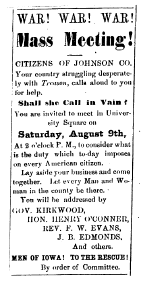
|
Where Was Camp Pope?
|
I started Camp Pope Bookshop in 1988, and named it for a Civil War mustering camp that was located near my home in Iowa City. The regiments that mustered at Camp Pope (the 22nd, 28th, and 40th Infantry Volunteers) were formed in response to Abraham Lincoln’s call for 300,000 volunteers in July of 1862. Camp Pope (named for General John Pope who was brought east from Missouri in 1862 to fight Robert E. Lee) was established in August 1862 on land next to Ralston Creek, north of the Mississippi and Missouri Railroad (later known as the Rock Island Railroad, known today as the Iowa Interstate Railroad), bordered on the west by present day Summit Street, on the east by Oakland Avenue and on the north by Seymour Avenue. According to Jacob Switzer, the southern boundary of the camp extended beyond the tracks, to Governor Kirkwood’s house on Wyoming Road (today Kirkwood Avenue) and that that portion of the camp was used as a parade ground. It may be that the land for the camp was owned and donated for that purpose by Samuel Kirkwood. There were some structures built, as identified on a map drawn by Capt. S. C. Jones, Co. A, 22nd Iowa, in the 1920s. These were auctioned off when the camp was closed in late December 1862; twenty-six buildings were sold, to be reused as farm sheds or homes. Local legends identify at least two present day homes as having originally come from Camp Pope. In 1926 a plaque commemorating the camp was attached to a large boulder and placed in the front yard of Today, the area that Camp Pope occupied is a residential neighborhood, with only the monument and some street names (Sheridan, Grant) left to mark its connection with the Civil War. Click here for some modern photographs of the Camp Pope area. |
 The impetus for a regiment made up of local men came from some former members of Co B, 1st Iowa Infantry, a 90-day regiment which had fought at Wilson’s Creek (August 10, 1861). A mass rally was held in Iowa City on August 9, 1862, to encourage enlistment. Local enthusiasm, plus the threat of a draft, ultimately brought out more than twice Iowa’s quota for this particular call for volunteers.
The impetus for a regiment made up of local men came from some former members of Co B, 1st Iowa Infantry, a 90-day regiment which had fought at Wilson’s Creek (August 10, 1861). A mass rally was held in Iowa City on August 9, 1862, to encourage enlistment. Local enthusiasm, plus the threat of a draft, ultimately brought out more than twice Iowa’s quota for this particular call for volunteers.
 Longfellow School at what would have been the northern edge of Camp Pope. Three
Longfellow School at what would have been the northern edge of Camp Pope. Three